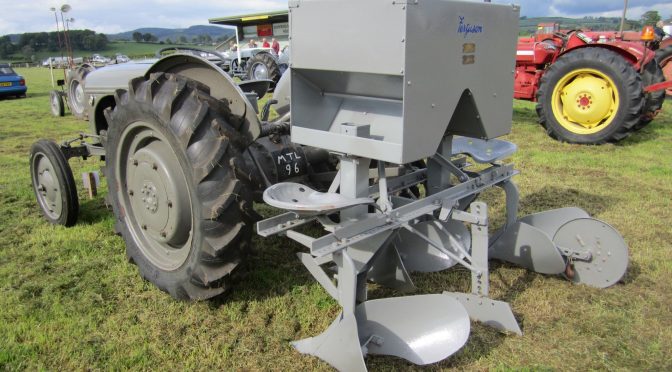The Highland Show or the general show of the Highland and Agricultural Society of Scotland, the national agricultural society, was the most important agricultural show in the farming calendar in Scotland. It was the focal point for the agricultural community in the district where it was held, enabling its members and exhibitors from further afield to exhibit their livestock and agricultural implements and machines. Each year until 1960 the show traveled around the country to a different show district, each of which focused on the main agricultural regions. These districts included the Dumfries Show District comprising the counties of Dumfries, Kirkcudbright and Wigtown, or the Dumfries and Galloway region. In the Dumfries show district the show was always held around or close to the town of Dumfries, at the heart of that show district and at ‘the centre of a wide agricultural territory’.
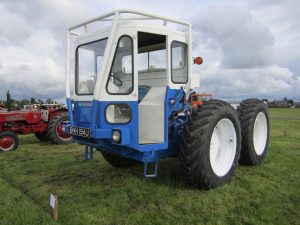
The implement department developed at a fast rate at the Dumfries Show. For Wellwood H. Maxwell, looking back over eight shows at Dumfries between 1830 and 1895, ‘perhaps in no department of the Show has there been a greater change than in that of implements. In the show of 1845 there were but 143 exhibits of implements. In 1895 the number was 2265.’ The rapid expansion of that department was also seen through the development of the ‘motion yard’ where machines were seen at work or in motion. In 1895 one observer commented that it ‘has perhaps made the most conspicuous advance during the past few years’. By 1910 it included some 50 of the 220 stands in the implement yard.
While the number of exhibits in the implement department increased significantly from 1830 until 1910, they also fluctuated between shows. They included the increasing importance of the show for the agricultural community, and the development of and changes to Scottish agriculture, including the increased mechanization of Scottish agriculture, especially from the 1850s and 1860s onwards, the development of the Scottish agricultural implement and machinery industry in these two decades, and the increasing range of manufactures made. By the 1890s larger scale makers of agricultural implements and machines were emerging which also acted as agents to provide a comprehensive range for the farmer and agriculturist. Wider economic conditions also had an impact: the 1860s and 1870s were favourable decades for Scottish agriculture (reflected in the significant increase in the number of implements at the Dumfries show and the large number of exhibits at the 1878 show). After 1879 British agriculture sank into a long-running agricultural depression that continued throughout the 1880s and 1890s, though it was not as severely felt in Scotland (reflected in the significant fluctuations in the number of implements at the Dumfries show). During such adverse economic conditions implement and machine makers were more reluctant to exhibit at the show as there were fewer opportunities of sales. That period of depression was followed by a more favourable period from 1906 until the First World War (and a slight increase in the number of implements exhibited as well as exhibitors).
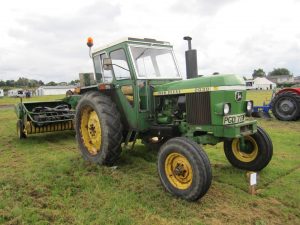
Wellwood H. Maxwell was clear about the importance of the implement department for the farmer and agriculturist. He saw it as being ‘by far and away the greatest emporium for the display and sale of all sorts of agricultural implements, and particularly of such implements as tend to increase the efficiency and reduce the cost of the labour of the farm’. For the 1895 show, he commented on their ‘varied and interesting collection’, also observing that ‘practically everything in the implement and machine way wanted on the farm is to be seen on one or other of the different stands’. In 1903, one reporter writing in the North British Agriculturist considered that ‘practically all classes of farm machinery’ were ‘represented’ in it. Another noted that ‘specimens of all classes of machinery in use on the farm at the present day’ were found. In 1910, there were:
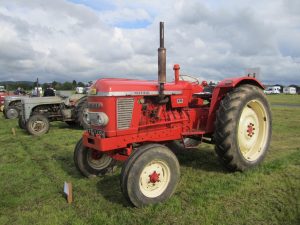
“Close on 2000 exhibits, representing practically every department of commerce catering for those engaged in the cultivation of land or in the breeding of live stock. The requirements of the great landowner, the gentleman farmer, the practical agriculturist, and the small holder are all kept in view, and the shedding in this section are filled with machinery, implements, seeds and their produce, artificial manures, feeding stuffs, veterinary preparations and appliances, and the numerous other articles, seemingly of endless variety, required in the equipment of the modern farm and estate.”
The exhibitors in the implement yard at the Dumfries Show included businesses from that show district. They provided a core of exhibitors at the Dumfries Show. There were always 21 or more of them at a show. They were present in similar numbers at consecutive shows, such as those of 1860, 1870 and 1878 and also 1886 and 1895. However, their role generally declined as the overall number of exhibitors to the show increased, especially after 1860; they declined significantly after 1878.
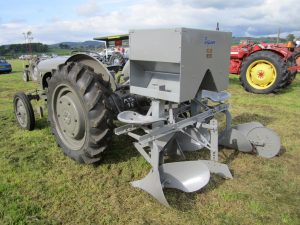
The exhibitors from the Dumfries show district exhibited at varying numbers of shows in that district. As the show was held every 8 or more years, most only exhibited at one or a small number of them. Before 1870 most of them only exhibited at one show. The first year when they started to exhibit at more than one was 1870. Though the number of these exhibitors fluctuated in following years, there was a tendency for the exhibitors at the 1895 and 1903 shows to also exhibit at later ones. However, only a small number exhibited at three or more shows: there were ten at three shows, four at four shows and four at five shows. The first exhibitors to exhibit at three shows did so in 1860 and continued until 1886. However, it was more usual for them to start at a later date: two started in 1870, another two in 1878, a further one in 1886; four started in 1895. Those that attended four shows first did so in 1878, though more usually from 1886; they continued to exhibit until 1910. Those at five shows exhibited from 1870 until 1903 or 1910.
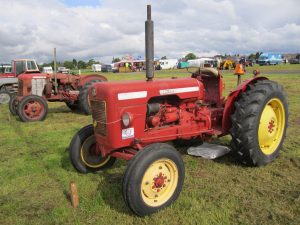
The most extensive exhibitors who exhibited at three or more shows had a distinct character. They were long-established businesses, also trading for a number of generations. As is revealed in their business names, they included a number of family members, usually a father and son or sons, though also other ones, as in the partnership of J. & R. Wallace, Castle Douglas. They included some of the best-known businesses in the district. For example, ‘no one was better known in the implement yard shows for many years’ than Thomas Turnbull who ‘never failed to exhibit at the Dumfries local shows’.
Most of the exhibitors from the Dumfries show district only exhibited at the Highland Show when it was held in Dumfries. They included ones that attended three or more shows: Andrew Boyd, Gavin Callander, William Cotts & Sons, James Gordon, Wellwood Herries Maxwell, and John Tweedie. However, some of them also exhibited at the show when it was held in other show districts. These could be shows held consecutively before or after the Dumfries show. Three exhibitors exhibited in this way, though for two of them their first show was not in their home show district. All of these show districts were in the south of Scotland, in the show districts of Perth, Stirling and Edinburgh. A further 11 exhibitors also exhibited in other show districts. These were either neighbouring ones, such as Kelso, or Glasgow, or a nearby one, always located in southern and central Scotland, such as Edinburgh, Stirling or Perth.
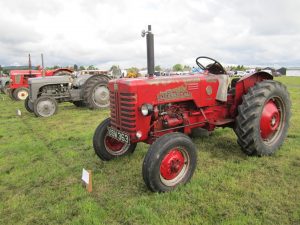
The exhibition patterns of the exhibitors demonstrate how they saw their businesses and how they promoted them and their manufactures. Exhibitors that only attended the show in the Dumfries show district focused on these aspects within that geographical area, acting as local businesses with a sphere of influence in the Dumfries and Galloway region. Ones that did so in two show districts had a wider sphere of influence, usually to a neighbouring show district or a nearby one in southern or central Scotland, though this was not always the case. Caldow & McKinnel, Maxwelltown, exhibited in three show districts that extended from the most northern one to the most southern: Inverness, Dumfries and Kelso in 1856, 1860 and 1863. Those that exhibited in six show districts had a much wider sphere of influence throughout most of the country. Ones that exhibited in all of them were national businesses with a national influence and standing. However, this latter type of exhibitor did not emerge until the 1890s.
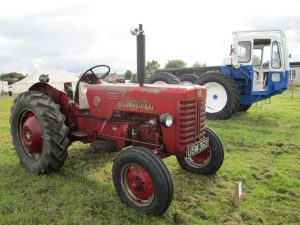
The exhibitors from the Dumfries show district included the most important agricultural implement and machine makers in that district. James Gordon established his business at Castle Douglas in 1865. In 1893 the North British Agriculturist could state that ‘from his long-established reputation for turning out first-class material, there is hardly a steading of any size in the Galloway district where some of “Gordon’s” implements are not to be found.’ Another of the leading makers was Thomas Turnbull, Dumfries. In 1869 one observer notes that ‘no one was better known amongst the farming community’ than him. By 1918 ‘specimens of his good, sound, and reliable workmanship may be seen all over the county’.
Some of them were renowned for making important innovations and developments in particular implements and machines that came to be more widely used throughout Scotland and further afield. Two were especially important in the development of the milking machine. John Gray, Stranraer, ‘an old-established’ maker in 1910, was considered to be ‘the original inventor of the milking machine’. J. & R. Wallace, Castle Douglas, was described as ‘pioneers in the invention of the milking machine’. Other machines were also important throughout Scotland. Thomas Turnbull’s ‘turntable broadcast sower’, of 1870 ‘will for all time be best associated with his name in the implement trade and amongst agriculturists’. One observer considered that:
There are few counties in Scotland where the sower is not at work. It is extensively used in Dumfriesshire, Kirkcudbrightshire, Wigtownshire, Berwickshire, and Ayrshire. Large numbers have been sold into the north, south, and midlands of England, into Ireland, and Wales, and a goodly number shipped to Australia, New Zealand, South African and America.
Thomas Payne’s patent adjustable scythe was widely used, with 900 being ‘sent out’ in 1860 alone. Mr Rome’s sheep dipping machine was exhibited at the Great Exhibition of 1851 and later at the Highland Show in 1854, 1860, 1876 and 1878.
Some of the exhibitors were also award-winning agricultural implement and machine makers. They gained their awards from a range of agricultural societies, usually at their annual shows. They included local societies, such as those at Torthorwald and Ruthwell, county societies including the Union Agricultural Society, as well as ones from further afield, in northern England, such as the East Cumberland Agricultural Society, and the national societies, the Highland and Agricultural Society of Scotland and the Royal Agricultural Society of England. William Cotts & Sons, established by 1860, won two premiums, a bronze medal and one soverign, in 1860 for its tools for cutting field drains from the Highland and Agricultural Society of Scotland. James B. A. McKinnel was another award-winner from that society, of a medium silver medal for his collection and his patent turnip drills, in 1870. In that year Thomas Turnbull also won a medium silver medal for his collection at the Highland Show. He won a total of six medals for his turntable broadcast sower, invented in 1870. James Payne, ironmonger, Kirkcudbright, secured three awards for scythes, including his patent adjustable scythe, in 1857, 1859 and 1860. J. & R. Wallace, Castle Douglas, was awarded a silver medal for its milking machine by the Royal Agricultural Society of England in 1905; it was one of a small number of Scottish implement and machine makers to receive a medal from that society. Its manure distributor also won the first prize of the ‘great Newcastle trials of the RASE’, and in 1910 ‘still continues to enjoy that measure of success which such a unique honour implies.’

The status of these local makers was reflected in their presence in the Dumfries showground. The most important ones commanded large stands. In 1895, A. Thomson, Dumfries, had ‘the largest stand of local firms engaged in the implement trade’, while James Gordon, Castle Douglas, ‘is a large exhibitor at the show’. In 1886 ‘Gordon & Coltart, of Castle Douglas and Dumfries, occupy a large space crowded with well-known implements’. Some of them also had comprehensive displays of implements and machines. In 1870 James B. A. McKinnel, Dumfries, exhibited ‘a great variety of farm implements in and out of motion’. In 1886 Gordon & Coltart had ‘a large and varied collection of useful implements’. At that same show, J. & R. Wallace, Castle Douglas, had ‘a goodly array of farm implements, including many of their own manufacture’. That maker had ‘a large and miscellaneous collection on view. In 1903 it had ‘an interesting assortment of machines’. In 1895, A. Thomson, Dumfries, ‘has a very extensive assortment of all kinds of implements’. In 1903 James Gordon ‘has on view a good collection of machines’. In 1910, John Gray, Stranraer, had ‘an excellent variety of cheese-making utensils for inspection’.
The next instalment will look at further aspects of the exhibition of implements and machines at the Highland Show in the Dumfries Show District.
The photographs were taken at the Dumfries vintage rally, 2014.
